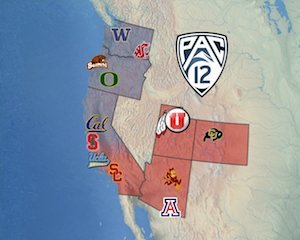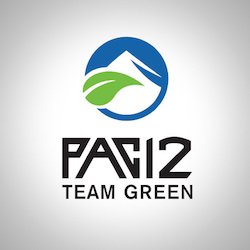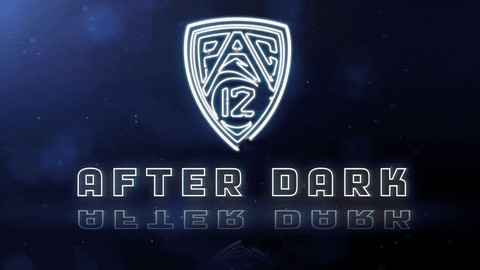Posted on July 16, 2020
|
This is the second installment of our question-and-answer series with Pac-12 executives, designed to help readers get to know key Conference professionals and their roles while also addressing important issues facing the League. Heather Vaughan, the Vice President of Marketing, graciously agreed to take part in our second interview.
***

Heather Vaughan is the Pac-12’s Vice President of Marketing and leader of all of the campaign strategies for the Conference’s initiatives. With over 20 years of experience, including 10 years with the Sacramento Kings, Vaughan’s role encompasses marketing the Pac-12 Networks, Men’s and Women’s Basketball Tournament, and the Football Championship Game.
At the helm of the overall look and feel of the Pac-12’s brand, she has led the way in marketing the Conference globally, and helped to elevate its reputation as a leader both on and off the field. Her dual role at the Pac-12 Conference and Pac-12 Networks ensures consistent strategy and messaging across all of the Conference’s platforms.
***
Dane Miller: You have an interesting and impressive background. How did your previous experience with the Sacramento Kings inform your views and approach to your current role with the Conference?
Heather Vaughan: The NBA and WNBA created several best practices across sports, including encouraging organizations to work together to share both their successes and misses so that we could all learn from each other. In doing so, the league created a sense of innovation. We all wanted to create benchmarks so we pushed boundaries in order to creatively meet objectives.
This mindset has been helpful within the Pac-12 Conference in that we work across the league to promote sharing, where applicable, with a strength-in-numbers mentality.
![]()
 The NBA and WNBA also knew that sports bring people together like nothing else, so it created the NBA and WNBA Cares umbrella brand to house all of the “do-good” initiatives that teams participated in, using the platform of the sport to highlight the importance of caring for your community and giving back.
The NBA and WNBA also knew that sports bring people together like nothing else, so it created the NBA and WNBA Cares umbrella brand to house all of the “do-good” initiatives that teams participated in, using the platform of the sport to highlight the importance of caring for your community and giving back.
The Pac-12 has similar values via its “imPACt” platform, amplifying what our 12 member Universities do in their local communities to leverage the power of sports in order to promote a culture of diversity and inclusion, give back to their communities and work to create a healthier earth for generations of student-athletes to come.
Dane Miller: The Pac-12 has a wide range of differences among its universities—academically, geographically, and culturally. How does that diversity shape the Conference’s marketing campaigns?
Heather Vaughan: We celebrate the unique differences across our Conference as it makes us who we are. The Conference has a storied history of shattering ceilings, breaking barriers and promoting diversity and equal opportunity as human excellence is the whole point of winning trophies.

Our geography has it all, from the ocean to the forest to the mountains to the desert, we embrace the pioneering spirit of the West. And when it comes to academics, the Pac-12 strives to create the next generation of leaders as the most important accomplishments our student-athletes achieve is receiving their diploma.
When it comes to creating our marketing campaigns, we look to celebrate all of this diversity because what all 12 universities have in common is that our students are champions in life.
Dane Miller: The Conference has made a point to expand into the Australian and Asian markets, particularly China. What were the driving forces that led to that initiative, and what have been some of the challenges in marketing the Pac-12 overseas? Also, are there plans for a similar initiative in Europe?
Heather Vaughan: Pac-12 member institutions are global, attracting thousands of international students, collaborating on research projects with the top global universities and sharing study-abroad experiences in hundreds of countries.
Simply put, the Pac-12 is Global.
Our Pac-12 Global initiative represents an unprecedented effort to promote goodwill and to showcase the Pac-12 and its member institutions around the world through student-athlete experiences, exchanges and sport. The initiative uses the shared passion of athletics to support the ambitious international strategies that Pac-12 universities have embarked upon to extend their reach into China and beyond.
 For close to a decade, Pac-12 Global has developed a robust strategy that entails four key pillars: academic initiatives, media distribution, events, and marketing & PR.
For close to a decade, Pac-12 Global has developed a robust strategy that entails four key pillars: academic initiatives, media distribution, events, and marketing & PR.
On the academic frontier, led by a partnership in China with the Federation of University Sports of China, Pac-12 Global hosts annual university sports symposiums in Shanghai around its Pac-12 China Game. In addition, Pac-12 Global has attracted university athletics leadership to Las Vegas for an annual global summit during the Pac-12 basketball tournament.
Over 500 international student-athletes compete at Pac-12 institutions and Pac-12 Global celebrates their achievements through both linear and digital platforms. In China, Pac-12 Global has its own Weibo and WeChat accounts that post content daily. In addition, Pac-12 Global has collaborated with the Pac-12 Networks to highlight the inspirational stories of Pac-12 international student athletes.
In coming years, Pac-12 Global looks to expand its presence in Japan via the Tokyo 2020 Olympic Games (now taking place in 2021) in which over 250 Pac-12 student-athletes and alumni will compete.
Dane Miller: The Pac-12’s “Zero Waste” initiative transcends sports and connects students, alumni, and fans with a cause that’s near and dear to many. How did the Conference conceive of the campaign, and what benefits has it yielded from a marketing standpoint?
Heather Vaughan: A first of its kind in collegiate athletics, Pac-12 Team Green serves to unite the Pac-12 Universities for a more sustainable future.
The Pac-12 was the first to host an annual Sustainability Conference highlighting several panels ranging in topics from the Greening of Championships to creating lasting programs for sustainable success to social and economic sustainability issues discussions.
In addition, the Pac-12 Zero Waste Challenge is one of the core pillars of Pac-12 Team Green and is an effective tool to fully engage the athletes, faculty, staff, students, fans, and the community at the athletic venue to show active commitment to zero waste and sustainability. The Zero waste program also provides an additional opportunity to add value to programs with current sponsorships and a way to market to new partners and sponsors.

The Pac-12 also integrates the “Team Green” initiative across all touchpoints when it comes to live events, from recycling programs for fans to refillable water bottle “hydration stations” to creating care kits for the homeless, Pac-12 fans, bands, spirit squads and mascots all get in on the sustainability game.
In addition, leftover food is recovered at Pac-12 events, diverting thousands of pounds of food from compost to feed the hungry. Bottles and cans are also collected by Team Green team members at Pac-12 events to recycle and the Conference hosts an annual beach clean-up at the conclusion of the Rowing Championship at Lake Natrona in Sacramento.
The benefits of Team Green are endless and the Conference hopes to continue to grow this initiative by leaning in on sustainability as it pertains to social and economic sustainability beyond environmental progress. The initiative has also opened the door to several creative partnerships that has encouraged the Conference to be more environmentally friendly across all of our touchpoints.
Dane Miller: Are there initiatives in the works for future signature Pac-12 events (such as the football championship game, or Men’s and Women’s Basketball Tournament) that you can share with us?
Heather Vaughan: The Pac-12 is constantly evolving and innovating; that’s what keeps us uniquely us. We’ve created so many new initiatives over the last decade (see above with Pac-12 Global, Team Green, imPACt, our Football Championship Game and the Basketball Tournaments all in Las Vegas, just to name a few) and plan for many more.
 Most recently, the Pac-12 created a series of initial steps to promote social justice and combat racism including the creation of a new head of diversity and inclusion position, the formation of a social justice and antiracism advisory group composed of a cross section of University athletic and academic leaders and student-athletes representing all 12 Universities.
Most recently, the Pac-12 created a series of initial steps to promote social justice and combat racism including the creation of a new head of diversity and inclusion position, the formation of a social justice and antiracism advisory group composed of a cross section of University athletic and academic leaders and student-athletes representing all 12 Universities.
The Conference also announced student-athlete forums to promote conversations of inclusion in order to listen, learn and do more. Much more to come, but these are just a few of what we’ve been working on to continue to innovate and evolve.
Dane Miller: How have the Conference’s marketing campaigns helped cut through the noise and sharpen the Pac-12’s national image in relation to the other Power 5 conferences?
Heather Vaughan: As mentioned above, the Pac-12 focuses on the strength of the student-athlete, noting that the athletes that participate in the Conference are students first. We cut through the noise by creating and celebrating initiatives that showcase the leadership of the student-athletes in everything they do.
From winning national titles to being the first in their fields, we know that Pac-12 student-athletes will change the world for the better so we do what we can to support that vision.
Dane Miller: What is the Pac-12’s current marketing strategy for overcoming the disadvantages of Conference events that start or end beyond the bedtimes of most East Coast viewers?
Heather Vaughan: As in many other ways that we celebrate our collective uniqueness in the Pac-12, our geographic location being on the West Coast and playing in the pacific and mountain time zones set us apart from our peer conferences.
Though there may be perceived disadvantages for our later kickoff times on Saturdays, our viewership for these games has actually increased as Pac-12 Football in these later time windows has little competition in terms of other live sporting events.

In addition, we have also seen an organic campaign of “Pac-12 After Dark” unfold over the past few years via social media with thrilling victories and late-game excitement for those last games of the day.
That being said, our conference office does work with our media partners, ESPN, FOX and Pac-12 Networks, and with our athletics departments to coordinate as best as possible on kickoff times throughout the season.
Dane Miller: Beyond traditional broadcast and social media, what other marketing avenues have proven effective for you at the Pac-12 Conference?
Heather Vaughan: At the Pac-12 we consider all of our earned media and owned outlets as ways to communicate. That’s not to say we don’t engage in paid marketing where applicable, but because we’re uniquely poised in owning and operating our own Pac-12 Networks, we see every touchpoint as a way to market.
Our student-athletes have powerful voices so we look to amplify those in everything we do, from hosting the only SALT (student-athlete leadership team) in which student-athletes have a voice and vote among our Pac-12 council, to working with alumni to share their stories in order to inspire our student-athletes and fans, nothing is off the table.
Most recently we’ve seen success in aggregating storylines across the league to tell a collective story like giving back across their local communities in the COVID-19 era, to celebrating Pride in each of the campuses own unique way, our hope and purpose is to shine a light on all of the work that our universities and student-athletes are doing to be champions in life.
Dane Miller: Thank you for your time and generosity in taking part in this interview.
Heather Vaughan: You’re welcome, thanks for including me!
—More from Dane Miller—
- Dane Miller’s Arizona vs. Clemson Sweet 16 Preview
- Dane Miller’s Pac-12 NCAA Tournament 2nd-Round Previews
- Dane Miller’s Pac-12 Friday 1st-Round Big Dance Preview
- Dane Miller’s Pac-12 1st-Round NCAA Tournament Previews
- Dane Miller’s 2024 Pac-12 Tournament Title Preview
- Dane Miller’s 2024 Pac-12 Tournament Semifinal Previews
- Dane Miller’s Pac-12 Tournament Previews for Mar 14
- Dane Miller’s Pac-12 Tournament Previews for Mar 13
- Daylight Savings Time & Jackson Shelstad’s Great Season
- Dane Miller’s Pac-12 Men’s Hoops Previews for Mar. 7
- Dane Miller’s Week 17 Pac-12 Hoops Players of Week Votes
- Dane Miller’s Pac-12 Men’s Hoops Previews for Mar. 2
- Miller: Why Don’t More People Know About KJ Simpson?
- Dane Miller’s Pac-12 Men’s Hoops Previews for Feb. 29
- Dane Miller’s Pac-12 Men’s Hoops Previews for Feb. 28
-
Dane Miller’s Arizona vs. Clemson Sweet 16 Preview
The Wildcats face the Tigers in Los Angeles with a chance to advance to the Elite Eight - March 28, 2024 -
Dane Miller’s Pac-12 NCAA Tournament 2nd-Round Previews
Arizona, Washington State, and Oregon will look to keep the conference momentum going - March 22, 2024 -
Dane Miller’s Pac-12 Friday 1st-Round Big Dance Preview
Colorado plays the lone conference game today as the Buffs are set to take on 7-seed Florida - March 22, 2024

